The AMD Ryzen Threadripper 1950X and 1920X Review: CPUs on Steroids
by Ian Cutress on August 10, 2017 9:00 AM ESTCPU Rendering Tests
Rendering tests are a long-time favorite of reviewers and benchmarkers, as the code used by rendering packages is usually highly optimized to squeeze every little bit of performance out. Sometimes rendering programs end up being heavily memory dependent as well - when you have that many threads flying about with a ton of data, having low latency memory can be key to everything. Here we take a few of the usual rendering packages under Windows 10, as well as a few new interesting benchmarks.
All of our benchmark results can also be found in our benchmark engine, Bench.
Corona 1.3: link
Corona is a standalone package designed to assist software like 3ds Max and Maya with photorealism via ray tracing. It's simple - shoot rays, get pixels. OK, it's more complicated than that, but the benchmark renders a fixed scene six times and offers results in terms of time and rays per second. The official benchmark tables list user submitted results in terms of time, however I feel rays per second is a better metric (in general, scores where higher is better seem to be easier to explain anyway). Corona likes to pile on the threads, so the results end up being very staggered based on thread count.
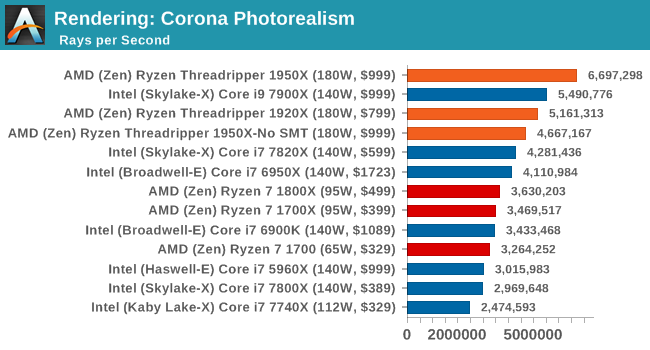
Corona loves threads.
Blender 2.78: link
For a render that has been around for what seems like ages, Blender is still a highly popular tool. We managed to wrap up a standard workload into the February 5 nightly build of Blender and measure the time it takes to render the first frame of the scene. Being one of the bigger open source tools out there, it means both AMD and Intel work actively to help improve the codebase, for better or for worse on their own/each other's microarchitecture.
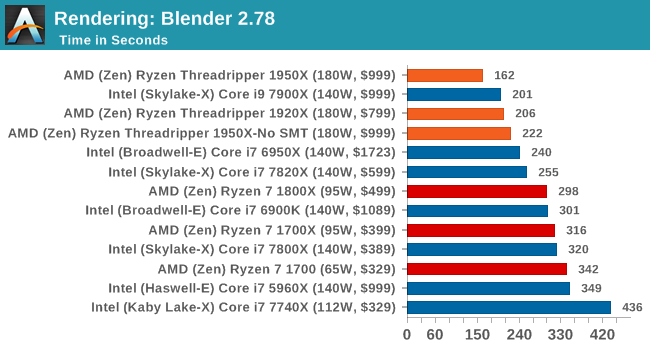
Blender loves threads and memory bandwidth.
LuxMark v3.1: Link
As a synthetic, LuxMark might come across as somewhat arbitrary as a renderer, given that it's mainly used to test GPUs, but it does offer both an OpenCL and a standard C++ mode. In this instance, aside from seeing the comparison in each coding mode for cores and IPC, we also get to see the difference in performance moving from a C++ based code-stack to an OpenCL one with a CPU as the main host.
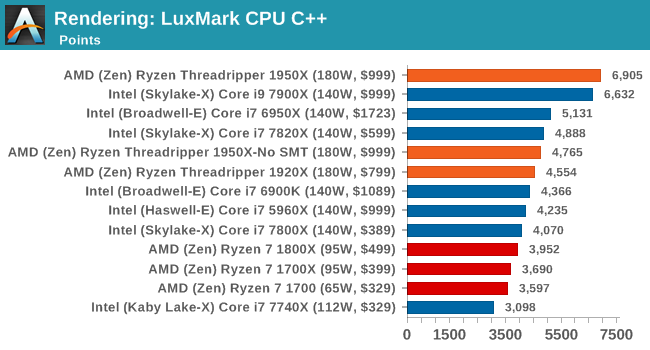
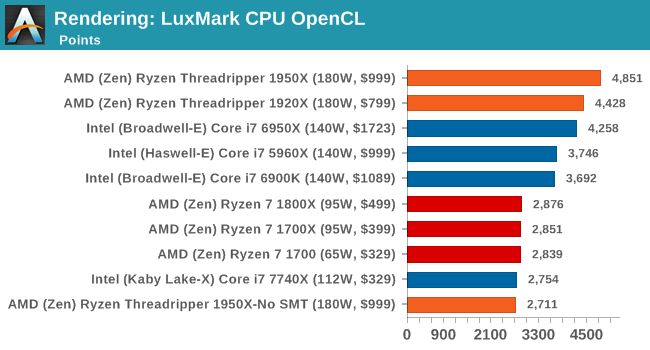
Like Blender, LuxMark is all about the thread count. Ray tracing is very nearly a textbook case for easy multi-threaded scaling. Though it's interesting just how close the 10-core Core i9-7900X gets in the CPU (C++) test despite a significant core count disadvantage, likely due to a combination of higher IPC and clockspeeds.
POV-Ray 3.7.1b4: link
Another regular benchmark in most suites, POV-Ray is another ray-tracer but has been around for many years. It just so happens that during the run up to AMD's Ryzen launch, the code base started to get active again with developers making changes to the code and pushing out updates. Our version and benchmarking started just before that was happening, but given time we will see where the POV-Ray code ends up and adjust in due course.
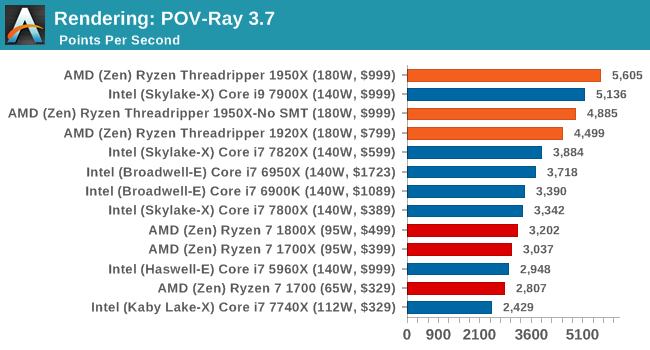
Similar to LuxMark, POV-Ray also wins on account of threads.
Cinebench R15: link
The latest version of CineBench has also become one of those 'used everywhere' benchmarks, particularly as an indicator of single thread performance. High IPC and high frequency gives performance in ST, whereas having good scaling and many cores is where the MT test wins out.
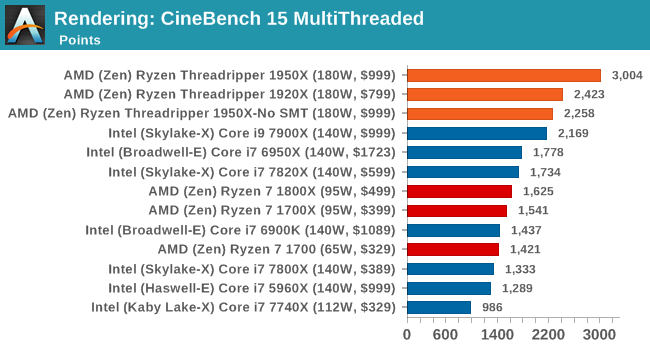
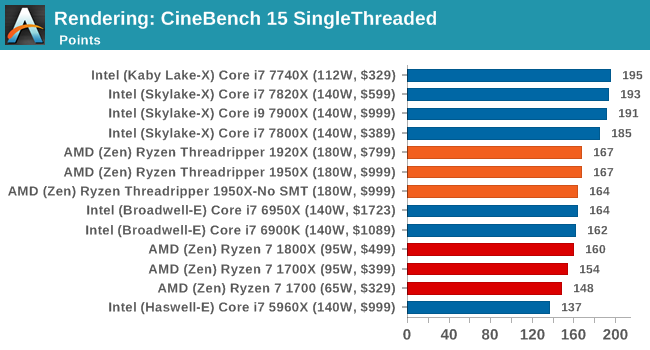
Intel recently announced that its new 18-core chip scores 3200 on Cinebench R15. That would be an extra 6.7% performance over the Threadripper 1950X for 2x the cost.










347 Comments
View All Comments
Ian Cutress - Thursday, August 10, 2017 - link
Anand hasn't worked at the website for a few years now. The author (me) is clearly stated at the top.Just think about what you're saying. If I was in Intel's pocket, we wouldn't be being sampled by AMD, period. If they were having major beef with how we were reporting, I'd either be blacklisted or consistently on a call every time there's been an AMD product launch (and there's been a fair few this year).
I've always let the results do the talking, and steered clear from hype generated by others online. We've gone in-depth into the how things are done the way they are, and the positives and negatives as to the methods of each action (rather than just ignoring the why). We've run the tests, and been honest about our results, and considered the market for the product being reviewed. My background is scientific, and the scientific method is applied rigorously and thoroughly on the product and the target market. If I see bullshit, I point it out and have done many times in the past.
I'm not exactly sure what you're problem is - you state that the review is 'slanted journalism', but fail to give examples. We've posted ALL of our review data that we have, and we have a benchmark database for anyone that ones to go through all the data at any time. That benchmark database is continually being updated with new CPUs and new tests. Feel free to draw your own conclusions if you don't agree with what is written.
Just note that a couple of weeks ago I was being called a shill for AMD. A couple of weeks before that, a shill for Intel. A couple before that... Nonetheless both companies still keep us on their sampling lists, on their PR lists, they ask us questions, they answer our questions. Editorial is a mile away from anything ad related and the people I deal with at both companies are not the ones dealing with our ad teams anyway. I wouldn't have it any other way.
MajGenRelativity - Thursday, August 10, 2017 - link
I personally always enjoy reading your reviews Ian. Even though they don't always reach the conclusions I hoped they would reach before reading, you have the evidence and benchmarks to back it up. Keep up the good work!Diji1 - Thursday, August 10, 2017 - link
Agreed!Zstream - Thursday, August 10, 2017 - link
For me, it isn't about "scientific benchmarking", it's about what benchmarks are used and what story is being told. I think, along with many others, would never buy a threadripper to open a single .pdf. I could be wrong, but I don't think that's the target audience Intel or AMD is aiming for.I mean, why not forgo the .pdf and other benchmarks that are really useless for this product and add multi-threaded use cases. For instance, why not test how many VM's and I/O is received, or launching a couple VM's, running a SQL DB benchmark, and gaming at the same time?
It could just be me, but I'm not going to buy a 7900x or 1950x for opening up .pdf files, or test SunSpider/Kraken lol. Hopefully we didn't include those benchmarks to tell a story, as mentioned above.
We're goingto be compiling, 3d rendering with multi-gpu's, running multiple VM's, all while multi-tasking with other apps.
My 2 cents.
DanNeely - Thursday, August 10, 2017 - link
Single threaded use cases aren't why people buy really wide CPUs. But performing badly in them, since they represent a lot of ordinary basic usage, can be a reason not to buy one. Also running the same benches on all products allows for them all to be compared readily vs having to hunt for benches covering the specific pair you're interested in.VM type benchmarks are more Johan's area since that's a traditional server workload. OTOH there's a decent amount of overlap with developer workloads there too so adding it now that we've got a compile test might not be a bad idea. On the gripping hand, any new benchmarks need to be fully automated so Ian can push an easy button to collect data while he works on analysis of results. Also the value of any new benchmark needs to be weighed against how much it slows the entire benching run down, and how much time rerunning it on a large number of existing platforms will take to generate a comparison set.
iwod - Thursday, August 10, 2017 - link
It really depends on use case. 20% slower on PDF opening? I dont care, because the time has reached diminishing returns and Intel needs to be MUCH faster for this to be a UX problem.But I think at $999 Intel has a strong case for its i9. But factoring in the MB AMD is still cheaper. Not sure if that is mentioned in the article.
Also note Intel is on their third iteration of 14nm, against a new 14nm from AMD GloFlo.
I am very excited for 7nm Zen 2 coming next year. I hope all the software and compiler as well as optimisation has time to catch up for Zen.
Zstream - Thursday, August 10, 2017 - link
I won't get into an argument, but I and many of my friends, who are on the developer side of the house have been waiting for this review, and it doesn't provide me with any useful information. I understand it might be Johan's wheelhouse, but come on... opening a damn .pdf file, and testing SunSpider/Kraken/gaming benchmarks? That won't provide anyone interested in either CPU any validation of purchase. I'm not trying to be salty, I just want some more damn details vs. trying to put both vendors in a good light.Ian Cutress - Thursday, August 10, 2017 - link
Rather than have 20 different tests for each set of different CPUs and very minimal overlap, we have a giant glove that has all the tests for every CPU in a single script. So 80 test points, rather than 4x20. The idea is that there are benchmarks for everyone, so you can ignore the ones that don't matter, rather than expect 100% of the benchmarks to matter (e.g. if you care about five tests, does it matter to you if the tests are published alongside 75 other tests, or do they have to be the only five tests in the review?). It's not a case of trying to put both vendors in a good light, it's a case of this is a universal test suite.Zstream - Thursday, August 10, 2017 - link
Well, show me a database benchmark, virtual machine benchmark, 3dmax benchmark, blender benchmark and I'll shutty ;)It's hard for me to look at this review outside of a gamers perspective, which I'm not. Sorry, just the way I see it. I'll wait for more pro-consumer benchmarks?
Johan Steyn - Thursday, August 10, 2017 - link
This is exactly my point as well. Why on earth so much focus on single threaded tests and games, since we all knew from way back TR was not going to be a winner here. Where are all the other benches as you mention. Oh, no, this will have Intel look bad!!!!!